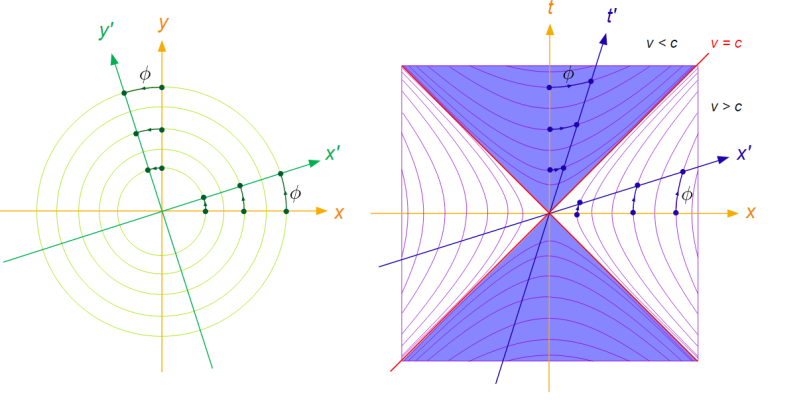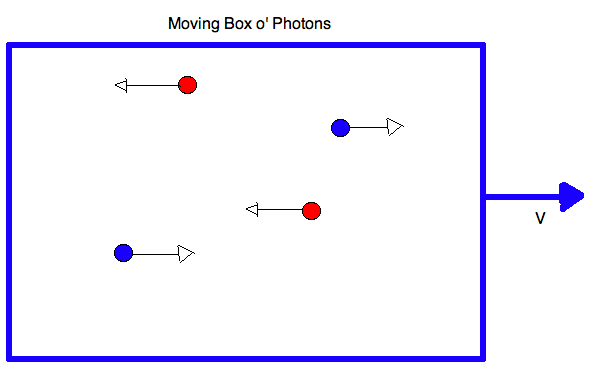


Distance in two dimensions:
In other words: if you go 4 steps west and 3 steps north, you travelled 5 steps of distance.
Or if you go 1 step west and 4 steps north, you travelled 4,1 steps of distance. Go less in one direction and you will travel a lesser distance. This makes sense.
All the point that are equally far away lay on a circle.
However in spacetime it is different:

Here, the distance formula is:
Notice the plus changed into a minus. What does this mean?
If you go 4 steps west while taking 3 minutes, you travelled a distance of ‘2,6 steps’ in spacetime.
If you go 4 steps west while taking 1 minute, you travelled a distance of ‘3,9 steps’ in spacetime.
4W+3N = 5 steps 4W+1N = 4.1 steps Distance decreases
4W+3T= 2.6 steps 4W+1T = 3.9 steps Distance increases
What are spacetime-distances?
This sounds weird, but we can’t imagine spacetime-distances, or intervals. So don’t try to imagine it. However, you can compare it to another spacetime-distance to understand why the ‘minus’ is there.
In other words, you somehow travelled ‘more spacetime’ than taking 1 minute than in 3 minutes. This sound a bit weird, since we ‘experienced’ less time and the same amount of space taking 3 minutes.
However, see it like this: It was way ‘harder’ to reach the point where you are (traveling the 4 steps in 1 minute instead of 3 minute, you have to travel faster).
In contrast: 4W1N was easier to get to, 4W1T was harder to get to. This is why the distances are different.
This translates in to you having travelled more ‘distance’ in spacetime. It takes more energy to do it. There is more ‘distance’ between the events.

The space-triangle and the spacetime-triangle:
Applying the pythagorean theorem to the perpendicular legs gives you the hypotenuse, which is the distance.
The perpendicular legs in the space-triangle are just the coordinates, with the hypotenuse being the distance.
However it seems if we look at the spacetime-interval formula that the perpendicular legs are time and the spacetime-interval with the hypotenuse being distance! This is so weird, why is the ‘distance’ variable smaller than one of the ‘coordinate’-variables.
Curve made up of same distances.
If you plot all the points that lie at the same space-distance of a point in space, you get a circle in 2D (ofcourse). Compare the formulas:
If you do the same in spacetime , you don’t get a circle. It would be silly to have a circle as ‘same distance’ plot. That would mean that 3 steps west would be just as far than 3 minutes waiting. And that you could go back in time.
However, the plot of all same distance points lies on a hyperbola. This follows, just as the sphere example, straight from the algebraic expression.
This is equivalent to the hyperbola expression.
The nice thing is that both the circle and the hyperbola share a property. They are both slices out of cones, or conic sections. The sphere is a perfect horizontal slice through a cone and the hyperbola is a perfect vertical slice through a cone.




Gas consists of millions and millions of particles. The particles bounce around in the box. The bouncing against the walls gives the wall little ‘pushes’. This creates pressure, and it is equal on all the walls.
Adding heat increases the average velocity of all the particles, creating more bouncing and thus a higher pressure in the box. Decreasing the volume increases the time the particle is bouncing off the wall, thus also increasing the pressure.
If you accelerate the box, all the particles get pushed to one side. This is analogous to you getting pushed into your car seat if you accerelate in the car.

This is because a fictitious force arises in an object that gets accelerated. This force pushes you back in the seat. It is there and ficitious because of your inertia (resistance to acceleration). I have other posts explaining inertia and fictitious forces.
The same thing happens in a box that accelerates. Accelerating ‘pushes’ all the particles to go ‘backwards’, they are getting ‘pushed into their seat’. So accelerating a box increases the pressure on one side. Which side would that be? Someone pushing against the box feels this extra ‘pressure’ as increased inertia.
Now imagine a box of lightparticles, or photons. The walls are mirrors, so the light gets reflected. The photons are bouncing around. In reality, you can’t keep light in a box with mirrors on the inside. Mirrors absorb a portion of the light that it encounters, making the light almost instantly absorbed. However, if we imagine perfect mirrors that only reflect you could keep light in a box.
Because of the reflections light exerts a ‘pressure’ on the walls. Just like the box of gas.

This box of light is analogous to the box of gas. There is one huge difference, the light is massless. So all the mass and inertia comes from the box itself. The light has no inertia because it has no mass. Or does it?
If you accelerate the box, just like the car and the box of gas, the pressure on one side will increase! Because of the same reason as the accelerating box of gas. The walls move into the gas and increases the amount of bouncing against that wall.
In this way, the box of light increases its inertia! Accelerating a box of light will create a pressure on one side of the box, increasing its inertia, despite the mass staying the same. Energy has inertia! In that way, energy is equivalent to mass.
Since the theory on electromagnetism (supposing that light isn’t a particle but a wave in electromagnetic fields) also supposes that electromagnetic waves have momentum and thus pressure, electromagnetic waves have inertia. This is referred to ‘electromagnetic mass’. (even though it has no mass)


What is mass? The mass of an object is a measure of its inertia: ‘The difficulty of changing the velocity’.
Inertia is that which resists acceleration. A full shopping cart takes more effort to push, and thus ‘resists’ acceleration more than an empty shopping cart. That is why we say that the full shopping cart has more inertia. In everyday words you say that it has more mass, more ‘stuff’ in it.
So in a sense, inertia is just a different name for mass. Newton definitely thought that. But is it?

Speed of light is constant, so there is an upper limit to speed.
Because the speed of light is constant for everyone, it is impossible to go at that speed or exceed it. Think about it, if someone can go at the speed of light, from his perspective light would stand still. This contradicts with the fact that speed of light goes at the same speed of everyone. So there is a speed limit in the universe.
But what actually prevents us from just accelerating past the speed of light? If you just keep adding kinetic energy to a rocket by burning a lot of fuel, surely you would accelerate passed the speed of light?
What actually prevents an object from exceeding that speed, is increasing inertia. Before 1900, it was believed that mass is inertia. All the resistance to acceleration comes from mass. The inertia is thus independent of the speed of the object, since mass is independent of speed. A full shopping cart at 100 m/s has the same inertia as that cart standing still.
However, since there is an absolute speed limit, inertia has to increase when you increase your speed. That means that if you come closer and closer to the speed of light, your spaceship will be harder and harder to accelerate. Usually this is said because of the increased ‘mass’ of the spaceship. However this is untrue, the mass is still the same.
The inertia is increasing. A spaceship at 80% speed of light has way more inertia, or resistance to acceleration, than a spaceship at rest. But where or what is this inertia?
It is because you are adding energy. Energy has inertia as well. This was unknown before 1900 and nothing suggested that energy has inertia. So by increasing the speed of a shopping cart, it will feel much fuller than when it is still.

The coins in relativity theory:
This is the true meaning of saying that mass is equivalent to energy. They are both two faces of the same thing which is inertia. The coin is inertia and the sides are energy and mass.
These two-sides of one coin is a major theme in the relativity theory. Energy-mass, Energy-momentum, Space-Time, Electricity-Magnetism.
Box of photons
I will make another post about a simple example of the fact that energy has inertia. It is about accelerating a box of photons (which are weightless, but do have inertia)
Even Einstein’s original paper on mass-energy equivalence has this in its title: “Does the Inertia of a body depend on its Energy-Content?”
A nice explanation:

Huygens: “Motus inter corpora relativus tantum est”
The motion of objects is relative.
This is two symmetry principles in one: (Something has a symmetry if it stays the same under a certain change)
Summed up in a different and mindblowing way: Position and Velocity are not measurable quantities of objects.
You don’t know where you are and you don’t know how fast you are going. You can only answer this relatively.
If the universe only had one particle in it, it would have no position and no velocity.
You also cannot answer the question if something is at rest. Everything is at rest from some perspective, and moving from other perspectives. Is this truly the case?
However, there is one exception: Light.
The velocity of light is absolute and a measurable quantity of that object. It cannot be at rest. This was discover in 1887.
It was first thought that Light always moved relative to a medium (called the ether). This in analogy to sound and waterwaves. Both of these are ‘shockwave’-phenomona in a medium. This medium has borders and it is not infinite, so you could see it as an object.
Shockwaves move faster in more rigid material (the sound speed is way higher in metal than air). Since light moves extremely fast, its medium had to be very rigid. It would also have to have no borders, or be infinite.


Being resistant to frustration is a basis to a good mentality in life.
Try to become compliant in life. When frustration happens (and it is certain that it will), be prepared to bounce instead of crash. Try to be a bouncing ball instead of a porcelain tea-cup.
Withstanding stress is more impressive than avoiding stress. Sometimes it is even good to choose to experience stress, as so to develop control and self-efficacy in those situations.
I was amazed in my internships by a doctor that worked the full night and when we saw a patient together (complicated case that made me very nervous and stressed) he stayed calm and positive. He was bouncing around, while I was prepared to shatter.

